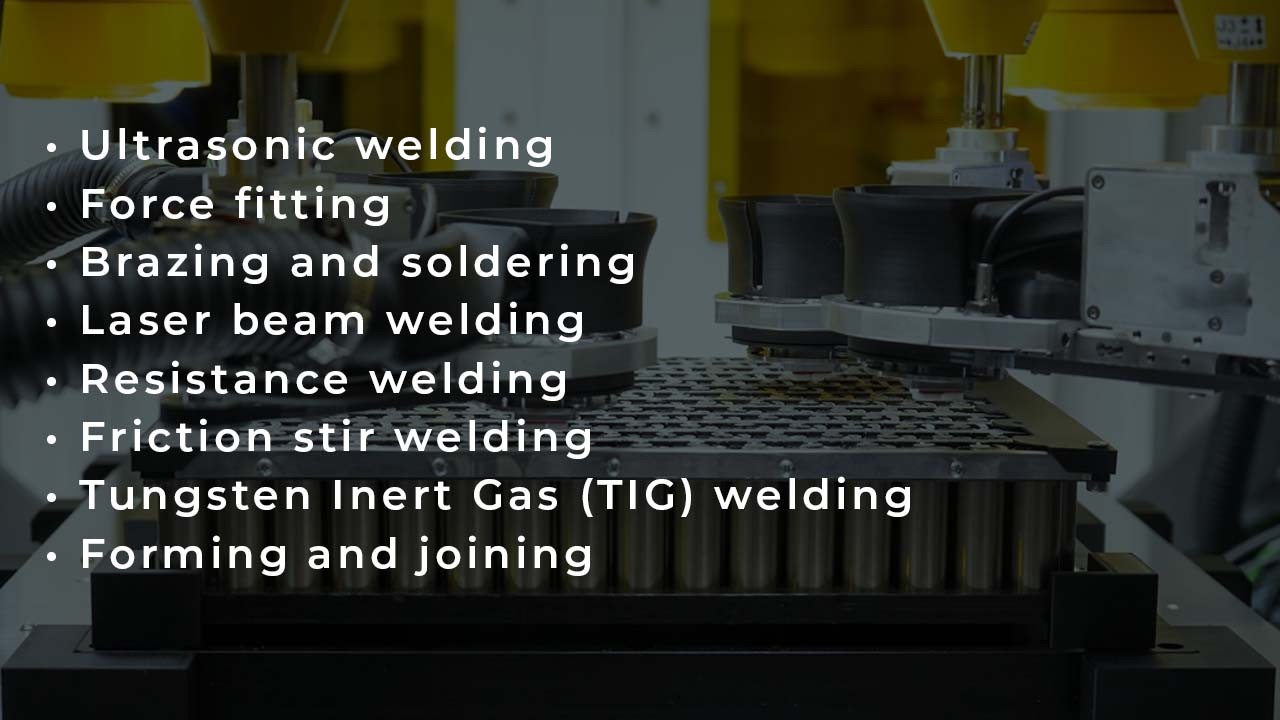
Ultrasonic Welding is a versatile manufacturing technology that is well-suited for thin sheets, wires, and conductive materials. It is also well-known for its self-tooling capabilities and ability to join dissimilar materials. Although it has benefits like low energy consumption and quick processing, it also has drawbacks like the requirement for exact clamping and incompatibility with thick, high-strength, and specific surface conditions materials.
Widely used in electronics, wire bonding excels at joining different materials and provides benefits for automation. Its suitability for thin wires, reduced joint strength, and manufacturing complexity are some of its drawbacks, especially in applications involving delicate components like batteries. The selection of the appropriate approach for a given set of circumstances requires careful consideration.
Force Fitting in mechanical assembly include simple disassembly and environmentally friendly recycling. Because of its cold process nature, it makes cost-effective repairs easier and is appropriate for components that are sensitive to temperature. But it has drawbacks as well, like the possibility of component damage if done incorrectly and excess weight from additional parts, making it inappropriate for applications where weight is a concern. Electrical conductivity and signal transmission may be impacted by high connection resistance. In addition, it’s a costly procedure that calls for specialized labor and precise tools. It might not be the most economical or expedient option in high-volume manufacturing. Force fitting has advantages such as easy disassembly and repair, but in certain manufacturing contexts, its disadvantages should be carefully evaluated.
Brazing and Soldering are two flexible methods that are widely used in the electronics industry because they work well for joining different kinds of materials. There are, however, a few disadvantages to these approaches. They raise expenses and raise the possibility of contamination since they call for the use of brazing or solder. Because these connections might not be as mechanically strong as those made using other welding techniques, joint strength can be a limitation. Remaining flux and debris can cause problems with cleanliness. Furthermore, the brazing and soldering procedures require a lot of labor and specialized personnel. In applications where compatibility is crucial, achieving successful dissimilar material joining can be difficult and requires careful material selection and process control.
Laser Beam Welding includes high-speed welding, precision, and low heat input. The process is non-contact and can be efficiently automated. High starting costs, though, could be a hindrance. Shielding gas is frequently required, and material reflectivity can have an impact on the quality of the weld. Maintaining quality control can be difficult, but precise joint alignment is essential. Real-time adjustments may be hampered by the complexity of process monitoring. Joining different materials also has its challenges.
To sum up, laser beam welding is a fast and accurate process, but it also requires a lot of money, careful setup, and ongoing quality control work, particularly when working with materials that are highly reflective or dissimilar.

Resistance Welding has many benefits, including low cost because it is an effective and fully automated process that doesn’t require any filler metals or gases. Thermal distortion is reduced by its low heat input and self-tooling nature. Additionally, it makes use of weld quality control technology currently in use. The possibility of expulsion during the procedure is a disadvantage, though, as are problems like electrode sticking and wear. Producing large joints and working with highly conductive materials can be difficult. Over-two-layer joins can also cause issues. Furthermore, joining materials of different kinds may be challenging. In conclusion, resistance welding has limits even though it is economical and effective, especially when it comes to specific material and joint configurations.
Friction Stir Welding is one notable solid-state joining method, which has several benefits. Its ability to combine different conductive and reflective materials is excellent, increasing its range of applications. Because the procedure uses a non-consumable tool, it is less harmful to the environment and does not require shielding gases or filler metals. Its versatility is increased by the availability of several process variants for diverse applications, such as spot, lap, and butt welding. There are restrictions to take into account, though. An empty exit hole may remain in the workpiece after friction stir welding. The process is sensitive to joint clamping quality, which could have an impact on the final weld, and proper clamping is crucial. Moreover, the technology may be costly, mostly because of the price of the equipment and tools.
Tungsten Inert Gas (TIG) Welding is an economical technique renowned for its ability to create fusion joints. It is simple to automate and efficiently combines reflective and conductive materials, increasing production efficiency. TIG welding produces joints with strong mechanical performance. Nevertheless, disadvantages include a large heat-affected zone caused by high thermal input, which may affect the properties of the material. Shielding gas is needed for the process, which raises operating expenses. Because different materials have different thermal expansion and conductivities, joining them can be difficult. Notwithstanding these drawbacks, TIG welding is still a well-liked option for a number of applications since it provides sturdy mechanical connections and fusion joints at a reasonable price.
Forming and Joining is a flexible process that can be used to join different conductive and reflective materials, making it suitable for a wide range of applications. It is a cold process that requires no heat, and it is easily automated to increase production efficiency. Nevertheless, one significant disadvantage is the possibility of temperature-induced softening, especially with aluminum components. It’s also possible that the process will add extra weight to the finished product, which could be problematic for applications where weight is an issue.
For More Updates Follow Us
WhatsApp – Facebook – Instagram – Twitter – LinkedIn – YouTube
